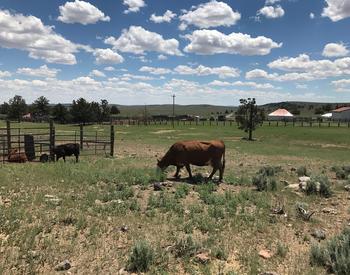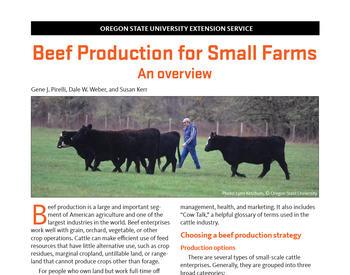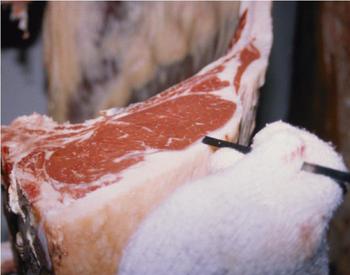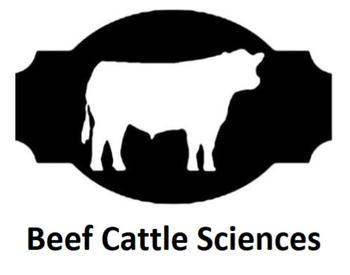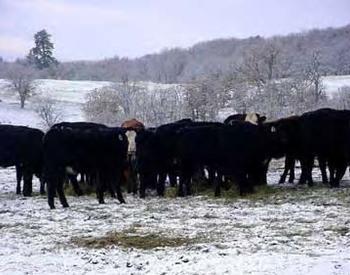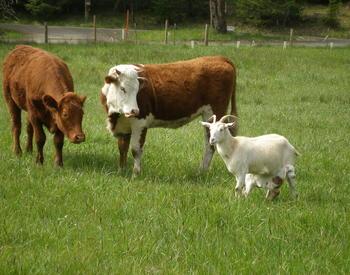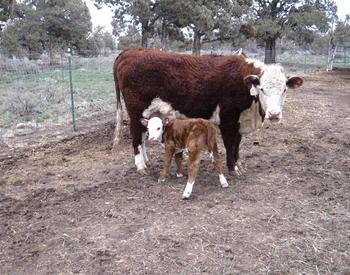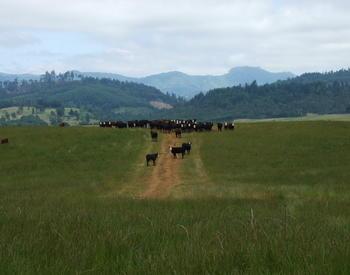Introduction
Cattle require certain nutrients in specific amounts in order to grow, thrive and reproduce. This fact sheet describes the nutrients, explains common terms used in feeds and feeding, and provides lists of nutrient requirements by animal type and productivity level. This makes it easier for livestock managers and nutritionists to balance rations that meet the nutrient requirements of livestock for the various activities (gain, reproduction, etc.) that the animals are expected to perform. For more information, please see the fact sheet on ration balancing in this library.
Classes of nutrients
Based on their properties, nutrients are placed into certain classes that include protein, carbohydrates, fat, vitamins, minerals and water. Proteins are nitrogen-containing molecules made up of various amino acids (building blocks) and are important for production of colostrum, building of muscle tissue (meat), and can be used for energy production and other important bodily functions.
Carbohydrates are nutrients that are part of a plant’s structural fibers, as well as soluble sugars within the cells. They are important for digestive processes and are used as an energy source by the animal. Fats are energy-dense nutrients that also have specific functions in animals; like helping to absorb certain vitamins, maintaining cell membranes and as precursors for hormones.
Energy is not a nutrient per se, but rather a product derived from proteins, carbohydrates and fats.
Vitamins are organic compounds that are “vital” to life. Minerals are inorganic compounds that are used in moderate (macrominerals) and small (microminerals) quantities. Both vitamins and minerals are co-factors in the processing of nutrients in the body. That is, they help the animal digest, absorb, and use other nutrients.
Water is another crucial part of a livestock nutrition program because it is required for every single process and reaction within the animal’s body. Livestock should always have access to adequate quantities of good-quality, clean water. Lack of water leads to decreased feed intake, lower production and reduced revenues.
Common terms and units
Many terms and units are used in describing the nutrient content of feeds and the nutrient requirements of beef cattle. A list of commonly used animal nutrition terms, along with a brief description of each, is included below. More in-depth explanations of these can be found in the OSU publications Beef Cattle Nutrition Workbook and Understanding Your Forage Test Results.
Basic terms
- As-fed basis — A way to express percentage of nutrients in a feed, including moisture. As-fed will equal as-sampled or as-received if the feed is not altered between sampling, testing and feeding time.
- Dry matter (DM) — The dry portion of the forage or feed sample (not including the water).
- Dry matter basis — A way to express percentage of nutrients in a feed without the moisture. At some point in the calculations, DM must be converted to as-fed basis for the final mixing and feeding.
- Moisture — The water portion of a sample.
- Relative feed value (RFV) — A measure of forage quality which takes into account forage digestibility (estimated from acid detergent fiber) and intake (estimated from neutral detergent fiber).
- Relative forage quality (RFQ) — A measure of forage quality similar but superior to RFV (Understander and Moore, 2009) in that it uses an improved method of estimating forage digestibility (total digestible nutrients) and intake (estimated from neutral detergent fiber). Both RVF and RFQ are used primarily for marketing hay. They are not nutrient requirements and are not used for balancing livestock rations.
Proteins and nitrogen
- Acid detergent insoluble nitrogen (ADIN or ADF-N) — A measure of the protein bound to fiber, particularly due to overheating of stored forage. This protein, which is indigestible, is called "heat damaged."
- Adjusted crude protein (Adjusted CP) — The crude protein adjusted for availability to the animal. Some proteins can be bound with fiber and are unavailable, especially in heat-damaged forages.
- Crude protein (CP) — An estimate of the protein content of the feed. Laboratories measure the nitrogen (N) content of the forage and then calculate crude protein using the formula CP = %N x 6.25.
- Natural proteins — Proteins made up of amino acids.
- Nitrates — A form of nitrogen that can be accumulated by forage plants under stressed conditions such as drought, freezing or heavy fertilization.
- Non-protein nitrogen (NPN) — Source of nitrogen that does not contain preformed amino acids. Ruminal microorganisms can effectively use NPN as a nitrogen source in the production of microbial protein
- Acid detergent fiber (ADF) — A measure of cellulose and lignin. ADF is negatively correlated with overall digestibility (high ADF, low digestibility).
- Neutral detergent fiber (NDF) — A measure of hemicellulose, cellulose and lignin that represents the fibrous bulk of the feed and is negatively correlated with intake (high NDF, low intake).
- Nonstructural carbohydrates (NSC) — Starches and sugars inside the cell that serve as energy sources for the animal.
Fats
- Crude fat — Fat and other ether extractable compounds. Fat is an energy-dense nutrient and contains 2.25 times the energy found in carbohydrates and proteins.
Vitamins
In ruminants, there are five classes of vitamins that are important when considering nutrient requirements. Vitamin A is likely the most important. Vitamins D, E, K and some of the B vitamins are also known to be essential.
Supplemental vitamins can be added to the diet through a trace mineral salt mixture.
Minerals
Macrominerals are those that are required in moderately small amounts (generally greater than 100 ppm in the diet) and include calcium (Ca), phosphorus (P), magnesium (Mg), sodium (Na), chloride (Cl), potassium (K) and sulfur (S).
Microminerals are those that are required in very small amounts (generally less than 100 ppm in the diet) and include cobalt (Co), copper (Cu), fluoride (F), iodine (I), iron (Fe), manganese (Mn), molybdenum (Mo), selenium (Se) and zinc (Zn).
Energy
Net energy (NE) — An estimate of the energy in a feed that is available to the animal after accounting for energy lost during digestion and metabolism. Estimates for NE are divided into NE for maintenance (NEm) and NE for gain (NEg) and are more precise than TDN.
Net energy for maintenance (NEm) — The energy value of a feed to maintain animal body functions and tissue without gain or loss of weight.
Net energy for gain (NEg) — The energy value of a feed used for body weight gain above that required for maintenance.
Total digestible nutrients (TDN) — An estimate of the energy in feedstuffs. It can be measured in the laboratory or estimated from nutrient content (using fiber alone or multiple nutrients).
Units
Parts per million (ppm) — Equal to mg/kg.
Milligram (mg) — One-thousandth of a gram.
Kilogram (kg) — Equal to one thousand grams.
Percent (%) — Amount percent; amount per 100 parts; X/100=%.
Nutrient requirements of various physical stages and groups
The specific amount of each nutrient required by beef cattle depends on the physiological state and performance level of the animals being fed. For example, total pounds of feed (intake), energy, protein, vitamins, minerals and water required differ for growing and finishing animals when compared with that of breeding animals. Further, stage of lactation or pregnancy, animal weight, rate of gain and many other factors also determine the nutritional requirements of cattle (Figures 1 and 2).
Requirements also may vary depending on previous diet. For example, when an animal has been on a limited diet and then is fed a more nutritious diet, the diet is utilized more efficiently in a compensatory manner. Nutrient requirements also differ depending on the frame score (structural size) of cattle (See Appendix 1 Tables 1-6 at the end of this article or download appendix 1). Water requirements for a cow-calf pair range from 12 to 20 gallons per day, whereas yearling cattle require 6 to 14 gallons per day.
Animals require absolute amounts of nutrients (pounds, ounces, milligrams, etc.), but when balancing rations it is convenient to look at that quantity as a percentage of the total amount. Because of this, book values often contain both absolute amounts and percentages. Livestock nutrient requirements have been compiled into tables that can be used to quantify animal needs as the first step to formulating balanced rations (Appendix 1 and 2 below). To use the tables you must first describe the animal and level of performance desired and then find the amount of each nutrient required for that animal. The following examples demonstrate how to use the tables.
Example 1: Growing steers
Assume you have 500 lb, medium-framed steer calves that you would like to have them gain about 1.5 lb/day. They have been consuming low-quality forage so categorize their growth as compensatory (compensating). Using Appendix 1 Tables 1-6 at the end of this article or download Appendix 1 (Growing and Finishing Cattle), find the section that lists nutrient requirements for the calves you have described. Note the estimated DM intake is 13.4 lb/d, which includes 1.4 lb protein and 8.0 lb TDN. Also note that these values are listed as a percentage of the total diet (10.4% protein, 59.5% TDN, 0.39% Ca, and 0.21% P). The percentages required in the diet can also be calculated from pounds of nutrient and total intake (1.4 lb CP / 13.4 lb DM intake x 100 = 10.4% CP).
Example 2: Mature beef cows
Assume the average weight of mature cows in your herd is 1,200 lb and that the cows are currently in late gestation. Using Appendix 2 at the end of this article or download Appendix 2 (Breeding Cattle), find the section that lists nutrient requirements for the cows described. Note the cows should be gaining about 0.9 lb/d, expected DM intake is 22.3 lb and requirements are 1.7 lb/d (7.8%) for protein and 11.8 lb/d (52.9%) for TDN.
Conclusions
The resources supplied here are meant to be an aid for understanding nutrients, feedstuff terms, laboratory results and animal nutrient requirements. They represent a starting point for balancing cattle rations with correct nutrient content to match a chosen level of productivity. Feeds available for meeting the livestock needs are as complex as the animal requirements. Therefore, it is suggested that a trained nutritionist be consulted for help with ration balancing. For more information, please see the fact sheets on feedstuffs and on ration balancing in this library.
References
Bohnert et al., 2004. Oregon State University. Beef Cattle Nutrition Workbook
National Research Council. 1984. Nutrient Requirements of Beef Cattle.
Arispe and Filley. 2016. Oregon State University. Understanding Your Forage Test Results
Cooke, Villarroel, and Estill. 2003. Oregon State University. Calving School Handbook
Understander and Moore. 2009. University of Florida. Relative Forage Quality
Appendices
Appendix 1 — Growing and finishing cattle
| Weight (lb) | Daily Gain (lb) | DM Intake (lb) | Protein (%) | Protein (lb) | TDN (%) | TDN (lb) | Ca (%) | P (%) |
|---|---|---|---|---|---|---|---|---|
| 300 | 0.5 | 7.8 | 9.6 | 0.75 | 54 | 4.2 | 0.27 | 0.18 |
| 1 | 8.4 | 11.4 | 0.95 | 58.5 | 4.9 | 0.38 | 0.21 | |
| 1.5 | 8.7 | 13.2 | 1.14 | 63 | 5.5 | 0.47 | 0.25 | |
| 2 | 8.9 | 14.8 | 1.32 | 67.5 | 6 | 0.56 | 0.26 | |
| 2.5 | 8.9 | 16.7 | 1.48 | 73.5 | 6.5 | 0.68 | 0.3 | |
| 3 | 8 | 19.9 | 1.6 | 85 | 6.8 | 1.13 | 0.47 | |
| 400 | 0.5 | 9.7 | 8.9 | 0.87 | 54 | 5.2 | 0.27 | 0.18 |
| 1 | 10.4 | 10.3 | 1.06 | 58.5 | 6.1 | 0.38 | 0.21 | |
| 1.5 | 10.8 | 11.5 | 1.24 | 63 | 6.8 | 0.47 | 0.25 | |
| 2 | 11 | 12.7 | 1.41 | 67.5 | 7.4 | 0.56 | 0.26 | |
| 2.5 | 11 | 14.2 | 1.56 | 73.5 | 8.1 | 0.68 | 0.3 | |
| 3 | 10 | 16.6 | 1.65 | 85 | 8.5 | 0.86 | 0.37 | |
| 500 | 0.5 | 11.5 | 8.5 | 0.98 | 54 | 6.2 | 0.25 | 0.17 |
| 1 | 12.3 | 9.5 | 1.16 | 58.5 | 7.2 | 0.32 | 0.2 | |
| 1.5 | 12.8 | 10.5 | 1.33 | 63 | 81 | 0.4 | 0.22 | |
| 2 | 13.1 | 11.4 | 1.49 | 67.5 | 8.8 | 0.47 | 0.24 | |
| 2.5 | 13 | 12.5 | 1.63 | 73.5 | 9.6 | 0.56 | 0.27 | |
| 3 | 11.8 | 14.4 | 1.69 | 85 | 10 | 0.69 | 0.32 | |
| 600 | 0.5 | 13.2 | 8.2 | 1.08 | 54 | 7.1 | 0.23 | 0.18 |
| 1 | 14.1 | 9 | 1.26 | 58.5 | 8.3 | 0.28 | 0.19 | |
| 1.5 | 14.7 | 9.8 | 1.42 | 63 | 9.3 | 0.35 | 0.21 | |
| 2 | 15 | 10.5 | 1.57 | 67.5 | 10.1 | 0.4 | 0.22 | |
| 2.5 | 14.9 | 11.4 | 1.69 | 73.5 | 11 | 0.46 | 0.24 | |
| 3 | 13.5 | 12.9 | 1.73 | 85 | 11.5 | 0.57 | 0.29 | |
| 700 | 0.5 | 14.8 | 7.9 | 1.18 | 54 | 8 | 0.22 | 0.18 |
| 1 | 15.8 | 8.6 | 1.35 | 58.5 | 9.2 | 0.27 | 0.18 | |
| 1.5 | 16.5 | 9.2 | 1.5 | 63 | 10.4 | 0.31 | 0.2 | |
| 2 | 16.8 | 9.8 | 1.65 | 67.5 | 11.3 | 0.34 | 0.21 | |
| 2.5 | 16.7 | 10.5 | 1.75 | 73.5 | 12.3 | 0.4 | 0.22 | |
| 3 | 15.2 | 11.7 | 1.77 | 85 | 12.9 | 0.49 | 0.26 | |
| 800 | 0.5 | 16.4 | 7.7 | 1.27 | 54 | 8.9 | 0.22 | 0.17 |
| 1 | 17.5 | 8.3 | 1.44 | 58.5 | 10.2 | 0.24 | 0.19 | |
| 1.5 | 18.2 | 8.8 | 1.58 | 63 | 11.5 | 0.28 | 0.19 | |
| 2 | 18.6 | 9.2 | 1.72 | 67.5 | 12.6 | 0.31 | 0.2 | |
| 2.5 | 18.5 | 9.8 | 1.81 | 73.5 | 13.6 | 0.35 | 0.21 | |
| 3 | 16.8 | 10.8 | 1.81 | 85 | 14.3 | 0.42 | 0.25 | |
| 900 | 0.5 | 17.9 | 7.6 | 1.36 | 54 | 9.7 | 0.21 | 0.18 |
| 1 | 19.1 | 8 | 1.52 | 58.5 | 11.2 | 0.23 | 0.18 | |
| 1.5 | 19.9 | 8.4 | 1.66 | 63 | 12.5 | 0.25 | 0.19 | |
| 2 | 20.3 | 8.8 | 1.79 | 67.5 | 13.7 | 0.28 | 0.2 | |
| 2.5 | 20.2 | 9.3 | 1.87 | 73.5 | 14.8 | 0.31 | 0.2 | |
| 3 | 18.3 | 10.1 | 1.85 | 85 | 15.6 | 0.37 | 0.23 | |
| 1000 | 0.5 | 19.3 | 7.5 | 1.45 | 54 | 10.4 | 0.21 | 0.18 |
| 1 | 20.7 | 7.8 | 1.6 | 58.5 | 12.1 | 0.21 | 0.18 | |
| 1.5 | 21.5 | 8.1 | 1.74 | 63 | 13.5 | 0.24 | 0.18 | |
| 2 | 22 | 8.4 | 1.85 | 67.5 | 14.9 | 0.25 | 0.19 | |
| 2.5 | 21.9 | 8.8 | 1.92 | 73.5 | 16.1 | 0.27 | 0.19 | |
| 3 | 19.8 | 9.5 | 1.88 | 85 | 16.8 | 0.32 | 0.22 |
| Weight (lb) | Daily Gain (lb) | DM Intake (lb) | Protein (%) | Protein (lb) | TDN (%) | TDN (lb) | Ca (%) | P (%) |
|---|---|---|---|---|---|---|---|---|
| 300 | 0.5 | 8.2 | 9.5 | 0.77 | 52.5 | 4.3 | 0.3 | 0.19 |
| 1 | 8.7 | 11.3 | 0.99 | 56 | 4.9 | 0.46 | 0.23 | |
| 1.5 | 9.1 | 12.9 | 1.19 | 59.5 | 5.4 | 0.58 | 0.27 | |
| 2 | 9.4 | 14.6 | 1.37 | 63.5 | 6 | 0.7 | 0.3 | |
| 2.5 | 9.6 | 16.3 | 1.55 | 67.5 | 6.5 | 0.85 | 0.34 | |
| 3 | 9.6 | 18 | 1.73 | 72 | 6.9 | 0.99 | 0.39 | |
| 3.5 | 9.3 | 20.3 | 1.88 | 78.5 | 7.3 | 1.16 | 0.45 | |
| 400 | 0.5 | 10.1 | 8.9 | 0.89 | 52.5 | 5.3 | 0.26 | 0.17 |
| 1 | 10.8 | 10.2 | 1.1 | 56 | 6 | 0.37 | 0.2 | |
| 1.5 | 11.3 | 11.4 | 1.3 | 59.5 | 6.7 | 0.47 | 0.23 | |
| 2 | 11.7 | 12.7 | 1.47 | 63.5 | 7.4 | 0.57 | 0.26 | |
| 2.5 | 11.9 | 13.9 | 1.64 | 67.5 | 8 | 0.65 | 0.3 | |
| 3 | 11.9 | 15.2 | 1.81 | 72 | 8.6 | 0.76 | 0.33 | |
| 3.5 | 11.5 | 16.9 | 1.94 | 78.5 | 9 | 0.9 | 0.36 | |
| 500 | 0.5 | 12 | 8.5 | 1 | 52.5 | 6.3 | 0.24 | 0.17 |
| 1 | 12.8 | 9.5 | 1.21 | 56 | 7.2 | 0.33 | 0.19 | |
| 1.5 | 13.4 | 10.4 | 1.4 | 59.5 | 8 | 0.39 | 0.21 | |
| 2 | 13.8 | 11.4 | 1.57 | 63.5 | 8.8 | 0.46 | 0.24 | |
| 2.5 | 14 | 12.4 | 1.73 | 67.5 | 9.5 | 0.55 | 0.25 | |
| 3 | 14 | 13.4 | 1.88 | 72 | 10.1 | 0.63 | 0.28 | |
| 3.5 | 13.6 | 14.7 | 2 | 78.5 | 10.7 | 0.73 | 0.32 | |
| 600 | 0.5 | 13.8 | 8.2 | 1.11 | 52.5 | 7.2 | 0.22 | 0.18 |
| 1 | 14.6 | 9 | 1.31 | 56 | 8.2 | 0.29 | 0.18 | |
| 1.5 | 15.3 | 9.7 | 1.5 | 59.5 | 9.1 | 0.35 | 0.2 | |
| 2 | 15.8 | 10.5 | 1.66 | 63.5 | 10 | 0.4 | 0.22 | |
| 2.5 | 16.1 | 11.3 | 1.81 | 67.5 | 10.9 | 0.47 | 0.23 | |
| 3 | 16.1 | 12.1 | 1.95 | 72 | 11.6 | 0.52 | 0.26 | |
| 3.5 | 15.6 | 13.2 | 2.05 | 78.5 | 12.2 | 0.61 | 0.28 | |
| 700 | 0.5 | 15.4 | 7.9 | 1.21 | 52.5 | 8.1 | 0.21 | 0.17 |
| 1 | 16.4 | 8.6 | 1.41 | 56 | 9.2 | 0.27 | 0.19 | |
| 1.5 | 17.2 | 9.2 | 1.59 | 59.5 | 10.2 | 0.31 | 0.19 | |
| 2 | 17.8 | 9.8 | 1.74 | 63.5 | 11.3 | 0.36 | 0.21 | |
| 2.5 | 18 | 10.5 | 1.88 | 67.5 | 12.2 | 0.4 | 0.22 | |
| 3 | 18 | 11.1 | 2.01 | 72 | 13 | 0.45 | 0.23 | |
| 3.5 | 17.5 | 12 | 2.1 | 78.5 | 13.7 | 0.52 | 0.26 | |
| 800 | 0.5 | 17.1 | 7.7 | 1.27 | 54 | 8.9 | 0.21 | 0.18 |
| 1 | 18.2 | 8.3 | 1.51 | 56 | 10.2 | 0.24 | 0.18 | |
| 1.5 | 19 | 8.8 | 1.68 | 59.5 | 11.3 | 0.28 | 0.19 | |
| 2 | 19.6 | 9.3 | 1.82 | 63.5 | 12.4 | 0.32 | 0.2 | |
| 2.5 | 19.9 | 9.8 | 1.96 | 67.5 | 13.4 | 0.35 | 0.21 | |
| 3 | 19.9 | 10.4 | 2.07 | 72 | 14.3 | 0.4 | 0.22 | |
| 3.5 | 19.3 | 11.1 | 2.15 | 78.5 | 15.2 | 0.45 | 0.24 | |
| 900 | 0.5 | 18.6 | 7.6 | 1.4 | 52.5 | 9.8 | 0.2 | 0.18 |
| 1 | 19.8 | 8 | 1.6 | 56 | 11.2 | 0.23 | 0.18 | |
| 1.5 | 20.8 | 8.5 | 1.77 | 59.5 | 12.4 | 0.27 | 0.18 | |
| 2 | 21.4 | 8.9 | 1.9 | 63.5 | 13.6 | 0.29 | 0.2 | |
| 2.5 | 21.8 | 9.3 | 2.03 | 67.5 | 14.7 | 0.31 | 0.2 | |
| 3 | 21.7 | 9.8 | 2.13 | 72 | 15.6 | 0.36 | 0.21 | |
| 3.5 | 21.1 | 10.4 | 2.19 | 78.5 | 16.6 | 0.4 | 0.23 | |
| 1000 | 0.5 | 20.2 | 7.5 | 1.49 | 52.5 | 10.6 | 0.2 | 0.17 |
| 1 | 21.5 | 7.8 | 1.69 | 56 | 12 | 0.23 | 0.17 | |
| 1.5 | 22.5 | 8.2 | 1.85 | 59.5 | 13.4 | 0.25 | 0.18 | |
| 2 | 23.2 | 8.6 | 1.98 | 63.5 | 14.7 | 0.27 | 0.18 | |
| 2.5 | 23.6 | 8.9 | 2.09 | 67.5 | 15.9 | 0.29 | 0.19 | |
| 3 | 23.6 | 9.3 | 2.19 | 72 | 17 | 0.32 | 0.2 | |
| 3.5 | 22.8 | 9.8 | 2.24 | 78.5 | 17.9 | 0.35 | 0.21 | |
| 1100 | 0.5 | 21.7 | 7.4 | 1.58 | 52.5 | 11.4 | 0.19 | 0.18 |
| 1 | 23.1 | 7.7 | 1.77 | 56 | 12.9 | 0.21 | 0.18 | |
| 1.5 | 24.1 | 8 | 1.93 | 59.5 | 14.3 | 0.23 | 0.18 | |
| 2 | 24.9 | 8.3 | 2.05 | 63.5 | 15.8 | 0.25 | 0.18 | |
| 2.5 | 25.3 | 8.5 | 2.16 | 67.5 | 17.1 | 0.26 | 0.18 | |
| 3 | 25.3 | 8.9 | 2.25 | 72 | 18.2 | 0.29 | 0.19 | |
| 3.5 | 24.5 | 9.3 | 2.28 | 78.5 | 19.2 | 0.32 | 0.21 |
| Weight (lb) | Daily Gain (lb) | DM Intake (lb) | Protein (%) | Protein (lb) | TDN (%) | TDN (lb) | Ca (%) | P (%) |
|---|---|---|---|---|---|---|---|---|
| 300 | 0.5 | 7.8 | 9.7 | 0.76 | 53.5 | 4.2 | 0.31 | 0.2 |
| 1 | 8.3 | 11.6 | 0.96 | 57.5 | 4.8 | 0.48 | 0.24 | |
| 1.5 | 8.6 | 13.4 | 1.15 | 61.5 | 5.3 | 0.62 | 0.28 | |
| 2 | 8.8 | 15.2 | 1.34 | 65.5 | 5.8 | 0.75 | 0.33 | |
| 2.5 | 8.9 | 17 | 1.52 | 70 | 6.2 | 0.92 | 0.37 | |
| 3 | 8.7 | 19.3 | 1.68 | 76.5 | 6.7 | 1.09 | 0.43 | |
| 400 | 0.5 | 9.6 | 9 | 0.87 | 53.5 | 5.1 | 0.28 | 0.18 |
| 1 | 10.3 | 10.4 | 1.07 | 57.5 | 5.9 | 0.39 | 0.21 | |
| 1.5 | 10.7 | 11.8 | 1.26 | 61.5 | 6.6 | 0.49 | 0.25 | |
| 2 | 11 | 13.1 | 1.44 | 65.5 | 7.2 | 0.6 | 0.28 | |
| 2.5 | 11.1 | 14.4 | 1.6 | 70 | 7.8 | 0.7 | 0.32 | |
| 3 | 10.8 | 16.1 | 1.74 | 76.5 | 8.3 | 0.84 | 0.37 | |
| 500 | 0.5 | 11.4 | 8.6 | 0.76 | 53.5 | 6.1 | 0.25 | 0.17 |
| 1 | 12.1 | 9.7 | 0.96 | 57.5 | 7 | 0.35 | 0.2 | |
| 1.5 | 12.7 | 10.7 | 1.15 | 61.5 | 7.8 | 0.42 | 0.23 | |
| 2 | 13 | 11.7 | 1.34 | 65.5 | 8.5 | 0.49 | 0.25 | |
| 2.5 | 13.1 | 12.8 | 1.52 | 70 | 9.2 | 0.59 | 0.27 | |
| 3 | 12.8 | 14.1 | 1.68 | 76.5 | 9.8 | 0.69 | 0.31 | |
| 600 | 0.5 | 13.1 | 8.3 | 1.08 | 53.5 | 7 | 0.24 | 0.19 |
| 1 | 13.9 | 9.2 | 1.27 | 57.5 | 8 | 0.3 | 0.19 | |
| 1.5 | 14.5 | 10 | 1.44 | 61.5 | 8.9 | 0.36 | 0.21 | |
| 2 | 14.9 | 10.8 | 1.61 | 65.5 | 9.8 | 0.43 | 0.24 | |
| 2.5 | 15 | 11.6 | 1.75 | 70 | 10.5 | 0.5 | 0.25 | |
| 3 | 14.7 | 12.7 | 1.86 | 76.5 | 11.2 | 0.57 | 0.29 | |
| 700 | 0.5 | 14.7 | 8 | 1.18 | 53.5 | 7.9 | 0.23 | 0.18 |
| 1 | 15.6 | 8.8 | 1.37 | 57.5 | 9 | 0.28 | 0.2 | |
| 1.5 | 16.3 | 9.4 | 1.53 | 61.5 | 10 | 0.32 | 0.2 | |
| 2 | 16.7 | 10.1 | 1.69 | 65.5 | 10.9 | 0.38 | 0.22 | |
| 2.5 | 16.8 | 10.8 | 1.82 | 70 | 11.8 | 0.43 | 0.24 | |
| 3 | 16.5 | 11.7 | 1.92 | 76.5 | 12.6 | 0.49 | 0.25 | |
| 800 | 0.5 | 16.2 | 7.8 | 1.27 | 53.5 | 8.7 | 0.22 | 0.19 |
| 1 | 17.3 | 8.4 | 1.45 | 57.5 | 9.9 | 0.25 | 0.19 | |
| 1.5 | 18 | 9 | 1.61 | 61.5 | 11.1 | 0.29 | 0.2 | |
| 2 | 18.5 | 9.5 | 1.76 | 65.5 | 12.1 | 0.33 | 0.21 | |
| 2.5 | 18.6 | 10.1 | 1.89 | 70 | 13 | 0.38 | 0.23 | |
| 3 | 18.2 | 10.8 | 1.97 | 76.5 | 13.9 | 0.44 | 0.24 | |
| 900 | 0.5 | 17.7 | 7.7 | 1.36 | 53.5 | 9.5 | 0.21 | 0.19 |
| 1 | 18.9 | 8.2 | 1.54 | 57.5 | 10.9 | 0.25 | 0.19 | |
| 1.5 | 19.7 | 8.6 | 1.69 | 61.5 | 12.1 | 0.28 | 0.19 | |
| 2 | 20.2 | 9.1 | 1.83 | 65.5 | 13.2 | 0.31 | 0.21 | |
| 2.5 | 20.3 | 9.6 | 1.95 | 70 | 14.2 | 0.34 | 0.22 | |
| 3 | 19.9 | 10.2 | 2.02 | 76.5 | 15.2 | 0.39 | 0.23 | |
| 1000 | 0.5 | 19.2 | 7.5 | 1.45 | 53.5 | 10.3 | 0.21 | 0.18 |
| 1 | 20.4 | 8 | 1.62 | 57.5 | 11.7 | 0.24 | 0.18 | |
| 1.5 | 21.3 | 8.4 | 1.77 | 61.5 | 13.1 | 0.26 | 0.19 | |
| 2 | 21.8 | 8.7 | 1.9 | 65.5 | 14.3 | 0.28 | 0.19 | |
| 2.5 | 22 | 9.1 | 2.01 | 70 | 15.4 | 0.31 | 0.2 | |
| 3 | 21.5 | 9.6 | 2.07 | 76.5 | 16.4 | 0.35 | 0.22 | |
| 1100 | 0.5 | 20.6 | 7.4 | 1.54 | 53.5 | 11 | 0.2 | 0.19 |
| 1 | 21.9 | 7.8 | 1.7 | 57.5 | 12.6 | 0.22 | 0.19 | |
| 1.5 | 22.9 | 8.1 | 1.85 | 61.5 | 14.1 | 0.24 | 0.19 | |
| 2 | 23.4 | 8.4 | 1.97 | 65.5 | 15.3 | 0.26 | 0.19 | |
| 2.5 | 23.6 | 8.7 | 2.07 | 70 | 16.5 | 0.28 | 0.2 | |
| 3 | 23.1 | 9.2 | 2.11 | 76.5 | 17.7 | 0.32 | 0.21 |
| Weight (lb) | Daily Gain (lb) | DM Intake (lb) | Protein (%) | Protein (lb) | TDN (%) | TDN (lb) | Ca (%) | P (%) |
|---|---|---|---|---|---|---|---|---|
| 300 | 0.5 | 7.9 | 9.7 | 0.77 | 52.5 | 4.1 | 0.31 | 0.2 |
| 1 | 8.4 | 11.7 | 0.98 | 56 | 4.7 | 0.47 | 0.24 | |
| 1.5 | 8.8 | 13.5 | 1.18 | 59.5 | 5.2 | 0.63 | 0.28 | |
| 2 | 9 | 15.1 | 1.38 | 62.5 | 5.6 | 0.76 | 0.32 | |
| 2.5 | 9.2 | 17 | 1.56 | 66.5 | 6.1 | 0.91 | 0.36 | |
| 3 | 9.2 | 18.8 | 1.74 | 70.5 | 6.5 | 1.08 | 0.43 | |
| 3.5 | 9.1 | 20.9 | 1.91 | 75.5 | 6.9 | 1.24 | 0.48 | |
| 4 | 8.2 | 24.7 | 2.04 | 86 | 7.1 | 1.53 | 0.59 | |
| 400 | 0.5 | 9.8 | 9 | 0.89 | 52.5 | 5.1 | 0.27 | 0.18 |
| 1 | 10.4 | 10.5 | 1.09 | 56 | 5.8 | 0.4 | 0.21 | |
| 1.5 | 10.9 | 11.9 | 1.29 | 59.5 | 6.5 | 0.51 | 0.24 | |
| 2 | 11.2 | 13.1 | 1.48 | 62.5 | 7 | 0.61 | 0.28 | |
| 2.5 | 11.4 | 14.5 | 1.65 | 66.5 | 7.6 | 0.72 | 0.31 | |
| 3 | 11.5 | 15.9 | 1.82 | 70.5 | 8.1 | 0.82 | 0.35 | |
| 3.5 | 11.3 | 17.5 | 1.98 | 75.5 | 8.5 | 0.96 | 0.39 | |
| 4 | 10.2 | 20.3 | 2.08 | 86 | 8.8 | 1.19 | 0.48 | |
| 500 | 0.5 | 11.6 | 8.6 | 1 | 52.5 | 6.1 | 0.25 | 0.19 |
| 1 | 12.3 | 9.8 | 1.2 | 56 | 6.9 | 0.36 | 0.21 | |
| 1.5 | 12.9 | 10.9 | 1.39 | 59.5 | 7.7 | 0.43 | 0.22 | |
| 2 | 13.2 | 11.8 | 1.58 | 62.5 | 8.3 | 0.52 | 0.25 | |
| 2.5 | 13.5 | 12.9 | 1.74 | 66.5 | 9 | 0.59 | 0.28 | |
| 3 | 13.6 | 14 | 1.9 | 70.5 | 9.6 | 0.68 | 0.31 | |
| 3.5 | 13.4 | 15.3 | 2.05 | 75.5 | 10.1 | 0.77 | 0.35 | |
| 4 | 12 | 17.5 | 2.13 | 86 | 10.3 | 0.97 | 0.4 | |
| 600 | 0.5 | 13.3 | 8.3 | 1.1 | 52.5 | 7 | 0.23 | 0.18 |
| 1 | 14.1 | 9.2 | 1.3 | 56 | 7.9 | 0.31 | 0.2 | |
| 1.5 | 14.8 | 10.1 | 1.48 | 59.5 | 8.8 | 0.37 | 0.21 | |
| 2 | 15.2 | 10.9 | 1.67 | 62.5 | 9.5 | 0.44 | 0.23 | |
| 2.5 | 15.5 | 11.8 | 1.82 | 66.5 | 10.3 | 0.51 | 0.26 | |
| 3 | 15.5 | 12.7 | 1.97 | 70.5 | 10.9 | 0.58 | 0.27 | |
| 3.5 | 15.3 | 13.7 | 2.11 | 75.5 | 11.6 | 0.66 | 0.3 | |
| 4 | 13.8 | 15.6 | 2.16 | 86 | 11.9 | 0.81 | 0.37 | |
| 700 | 0.5 | 14.9 | 8 | 1.2 | 52.5 | 7.8 | 0.22 | 0.18 |
| 1 | 15.9 | 8.8 | 1.4 | 56 | 8.9 | 0.29 | 0.19 | |
| 1.5 | 16.6 | 9.6 | 1.57 | 59.5 | 9.9 | 0.35 | 0.21 | |
| 2 | 17 | 10.2 | 1.75 | 62.5 | 10.6 | 0.39 | 0.22 | |
| 2.5 | 17.4 | 11 | 1.9 | 66.5 | 11.6 | 0.44 | 0.24 | |
| 3 | 17.5 | 11.7 | 2.04 | 70.5 | 12.3 | 0.5 | 0.25 | |
| 3.5 | 17.2 | 12.5 | 2.16 | 75.5 | 12.3 | 0.5 | 0.25 | |
| 4 | 15.5 | 14.1 | 2.2 | 86 | 13.3 | 0.7 | 0.33 | |
| 800 | 0.5 | 16.5 | 7.9 | 1.3 | 52.5 | 8.7 | 0.21 | 0.19 |
| 1 | 17.5 | 8.5 | 1.49 | 56 | 9.8 | 0.26 | 0.19 | |
| 1.5 | 18.3 | 9.1 | 1.66 | 59.5 | 10.9 | 0.31 | 0.2 | |
| 2 | 18.8 | 9.7 | 1.84 | 62.5 | 11.8 | 0.35 | 0.21 | |
| 2.5 | 19.2 | 10.3 | 1.97 | 66.5 | 12.8 | 0.4 | 0.23 | |
| 3 | 19.3 | 10.9 | 2.11 | 70.5 | 13.6 | 0.45 | 0.24 | |
| 3.5 | 19 | 11.6 | 2.22 | 75.5 | 14.3 | 0.5 | 0.26 | |
| 4 | 17.1 | 13 | 2.24 | 86 | 14.7 | 0.61 | 0.31 | |
| 900 | 0.5 | 18 | 7.7 | 1.39 | 52.5 | 9.5 | 0.22 | 0.18 |
| 1 | 19.2 | 8.3 | 1.58 | 56 | 10.8 | 0.25 | 0.18 | |
| 1.5 | 20 | 8.8 | 1.74 | 59.5 | 11.9 | 0.29 | 0.2 | |
| 2 | 20.6 | 9.2 | 1.92 | 62.5 | 12.9 | 0.32 | 0.2 | |
| 2.5 | 21 | 9.8 | 2.04 | 66.5 | 14 | 0.36 | 0.21 | |
| 3 | 21.1 | 10.3 | 2.17 | 70.5 | 14.9 | 0.4 | 0.23 | |
| 3.5 | 20.8 | 10.9 | 2.27 | 75.5 | 15.7 | 0.45 | 0.24 | |
| 4 | 18.7 | 12.1 | 2.27 | 86 | 16.1 | 0.53 | 0.28 | |
| 1000 | 0.5 | 19.5 | 7.6 | 1.48 | 52.5 | 10.2 | 0.21 | 0.18 |
| 1 | 20.7 | 8.1 | 1.66 | 56 | 11.6 | 0.25 | 0.19 | |
| 1.5 | 21.7 | 8.5 | 1.83 | 59.5 | 12.9 | 0.27 | 0.19 | |
| 2 | 22.3 | 8.9 | 1.99 | 62.5 | 13.9 | 0.3 | 0.2 | |
| 2.5 | 22.7 | 9.3 | 2.11 | 66.5 | 15.1 | 0.33 | 0.2 | |
| 3 | 22.8 | 9.7 | 2.23 | 70.5 | 16.1 | 0.36 | 0.21 | |
| 3.5 | 22.5 | 10.3 | 2.32 | 75.5 | 17 | 0.4 | 0.24 | |
| 4 | 20.2 | 11.3 | 2.3 | 86 | 17.4 | 0.48 | 0.27 | |
| 1100 | 0.5 | 20.9 | 7.5 | 1.57 | 52.5 | 11 | 0.21 | 0.19 |
| 1 | 22.3 | 7.9 | 1.75 | 56 | 12.5 | 0.23 | 0.19 | |
| 1.5 | 23.3 | 8.3 | 1.91 | 59.5 | 13.9 | 0.26 | 0.19 | |
| 2 | 23.9 | 8.6 | 2.07 | 62.5 | 14.9 | 0.28 | 0.19 | |
| 2.5 | 24.2 | 9 | 2.18 | 66.5 | 16.1 | 0.3 | 0.2 | |
| 3 | 24.5 | 9.3 | 2.29 | 70.5 | 17.3 | 0.32 | 0.21 | |
| 3.5 | 24.1 | 9.8 | 2.37 | 75.5 | 18.2 | 0.36 | 0.22 | |
| 4 | 21.7 | 10.7 | 2.33 | 86 | 18.7 | 0.43 | 0.25 |
| Weight (lb) | Daily Gain (lb) | DM Intake (lb) | Protein (%) | Protein (lb) | TDN (%) | TDN (lb) | Ca (%) | P (%) |
|---|---|---|---|---|---|---|---|---|
| 300 | 0.5 | 7.5 | 9.6 | 0.73 | 56 | 4.2 | 0.29 | 0.21 |
| 1 | 8 | 11.4 | 0.91 | 62 | 5 | 0.44 | 0.22 | |
| 1.5 | 8.2 | 13.1 | 1.08 | 68.5 | 5.6 | 0.59 | 0.27 | |
| 2 | 8 | 15.1 | 1.22 | 77 | 6.2 | 0.74 | 0.33 | |
| 400 | 0.5 | 9.3 | 8.9 | 0.84 | 56 | 5.2 | 0.26 | 0.19 |
| 1 | 9.9 | 10.2 | 1.01 | 62 | 6.1 | 0.36 | 0.2 | |
| 1.5 | 10.2 | 11.4 | 1.17 | 68.5 | 7 | 0.45 | 0.24 | |
| 2 | 10 | 12.9 | 1.29 | 77 | 7.7 | 0.57 | 0.29 | |
| 500 | 0.5 | 11 | 8.5 | 0.94 | 56 | 6.2 | 0.24 | 0.18 |
| 1 | 11.8 | 9.4 | 1.11 | 62 | 7.3 | 0.3 | 0.21 | |
| 1.5 | 12.1 | 10.3 | 1.25 | 68.5 | 8.4 | 0.38 | 0.22 | |
| 2 | 11.8 | 11.4 | 1.35 | 77 | 9.1 | 0.45 | 0.24 | |
| 600 | 0.5 | 12.6 | 8.1 | 1.04 | 56 | 7.1 | 0.23 | 0.18 |
| 1 | 13.5 | 8.8 | 1.19 | 62 | 8.4 | 0.28 | 0.2 | |
| 1.5 | 13.8 | 9.5 | 1.32 | 68.5 | 9.5 | 0.32 | 0.21 | |
| 2 | 13.5 | 10.4 | 1.41 | 77 | 10.4 | 0.38 | 0.23 | |
| 700 | 0.5 | 14.1 | 7.9 | 1.13 | 56 | 8 | 0.22 | 0.19 |
| 1 | 15.1 | 8.4 | 1.28 | 62 | 9.4 | 0.25 | 0.19 | |
| 1.5 | 15.5 | 9 | 1.39 | 68.5 | 10.6 | 0.28 | 0.2 | |
| 2 | 15.2 | 9.6 | 1.46 | 77 | 11.7 | 0.32 | 0.22 | |
| 800 | 0.5 | 15.6 | 7.7 | 1.22 | 56 | 8.7 | 0.21 | 0.18 |
| 1 | 16.7 | 8.1 | 1.36 | 62 | 10.4 | 0.22 | 0.18 | |
| 1.5 | 17.2 | 8.5 | 1.46 | 68.5 | 11.8 | 0.24 | 0.19 | |
| 2 | 16.8 | 9 | 1.51 | 77 | 12.9 | 0.28 | 0.2 | |
| 900 | 0.5 | 17.1 | 7.5 | 1.31 | 56 | 9.6 | 0.21 | 0.18 |
| 1 | 18.3 | 7.8 | 1.44 | 62 | 11.3 | 0.22 | 0.18 | |
| 1.5 | 18.8 | 8.1 | 1.53 | 68.5 | 12.9 | 0.22 | 0.19 | |
| 2 | 18.3 | 8.5 | 1.56 | 77 | 14.1 | 0.25 | 0.19 | |
| 1000 | 0.5 | 18.5 | 7.4 | 1.39 | 56 | 10.4 | 0.2 | 0.19 |
| 1 | 19.8 | 7.6 | 1.51 | 62 | 12.3 | 0.2 | 0.18 | |
| 1.5 | 20.3 | 7.8 | 1.59 | 68.5 | 13.9 | 0.21 | 0.18 | |
| 2 | 19.8 | 8.1 | 1.61 | 77 | 15.2 | 0.22 | 0.19 |
| Weight (lb) | Daily Gain (lb) | DM Intake (lb) | Protein (%) | Protein (lb) | TDN (%) | TDN (lb) | Ca (%) | P (%) |
|---|---|---|---|---|---|---|---|---|
| 300 | 0.5 | 7.8 | 9.5 | 0.76 | 54 | 4.2 | 0.31 | 0.2 |
| 1 | 8.4 | 11.3 | 0.95 | 59 | 5 | 0.45 | 0.24 | |
| 1.5 | 8.8 | 13 | 1.13 | 64 | 5.6 | 0.58 | 0.25 | |
| 2 | 8.9 | 14.6 | 1.3 | 69.5 | 6.2 | 0.69 | 0.3 | |
| 2.5 | 8.7 | 16.7 | 1.45 | 77 | 7 | 0.86 | 0.35 | |
| 400 | 0.5 | 9.7 | 8.9 | 0.87 | 54 | 5.2 | 0.27 | 0.18 |
| 1 | 10.5 | 10.1 | 1.06 | 59 | 6.2 | 0.36 | 0.21 | |
| 1.5 | 10.9 | 11.3 | 1.23 | 64 | 7 | 0.45 | 0.22 | |
| 2 | 11.1 | 12.6 | 1.38 | 69.5 | 7.7 | 0.54 | 0.26 | |
| 2.5 | 10.8 | 14.1 | 1.51 | 77 | 8.3 | 0.65 | 0.31 | |
| 500 | 0.5 | 11.5 | 8.4 | 0.98 | 54 | 6.1 | 0.23 | 0.17 |
| 1 | 12.4 | 9.4 | 1.16 | 59 | 7.3 | 0.3 | 0.2 | |
| 1.5 | 12.9 | 10.3 | 1.32 | 64 | 8.3 | 0.38 | 0.2 | |
| 2 | 13.1 | 11.2 | 1.46 | 69.5 | 9.1 | 0.44 | 0.24 | |
| 2.5 | 12.8 | 12.4 | 1.57 | 77 | 10 | 0.53 | 0.26 | |
| 600 | 0.5 | 13.2 | 8.1 | 1.08 | 54 | 7.1 | 0.22 | 0.18 |
| 1 | 14.1 | 8.9 | 1.25 | 59 | 8.3 | 0.28 | 0.19 | |
| 1.5 | 14.8 | 9.6 | 1.41 | 64 | 9.5 | 0.33 | 0.19 | |
| 2 | 15 | 10.3 | 1.54 | 69.5 | 10.4 | 0.38 | 0.22 | |
| 2.5 | 14.6 | 11.2 | 1.63 | 77 | 11.2 | 0.44 | 0.24 | |
| 700 | 0.5 | 14.8 | 7.9 | 1.18 | 54 | 8 | 0.21 | 0.18 |
| 1 | 15.9 | 8.5 | 1.34 | 59 | 9.4 | 0.25 | 0.18 | |
| 1.5 | 16.6 | 9 | 1.49 | 64 | 10.6 | 0.29 | 0.19 | |
| 2 | 16.8 | 9.6 | 1.61 | 69.5 | 11.7 | 0.33 | 0.2 | |
| 2.5 | 16.4 | 10.3 | 1.68 | 77 | 12.6 | 0.38 | 0.22 | |
| 800 | 0.5 | 16.4 | 7.7 | 1.27 | 54 | 8.9 | 0.2 | 0.17 |
| 1 | 17.6 | 8.2 | 1.43 | 59 | 10.4 | 0.24 | 0.18 | |
| 1.5 | 18.3 | 8.6 | 1.57 | 64 | 11.7 | 0.25 | 0.18 | |
| 2 | 18.6 | 9 | 1.67 | 69.5 | 12.9 | 0.28 | 0.19 | |
| 2.5 | 18.1 | 9.6 | 1.74 | 77 | 13.9 | 0.33 | 0.21 | |
| 900 | 0.5 | 17.8 | 7.5 | 1.36 | 54 | 9.6 | 0.2 | 0.18 |
| 1 | 19.2 | 7.9 | 1.52 | 59 | 11.3 | 0.24 | 0.18 | |
| 1.5 | 20 | 8.2 | 1.64 | 64 | 12.8 | 0.25 | 0.18 | |
| 2 | 20.3 | 8.6 | 1.74 | 69.5 | 14.1 | 0.28 | 0.18 | |
| 2.5 | 19.8 | 9 | 1.78 | 77 | 15.2 | 0.33 | 0.2 | |
| 1000 | 0.5 | 19.3 | 7.4 | 1.45 | 54 | 10.4 | 0.19 | 0.18 |
| 1 | 20.8 | 7.7 | 1.6 | 59 | 12.3 | 0.21 | 0.18 | |
| 1.5 | 21.7 | 8 | 1.71 | 64 | 13.9 | 0.21 | 0.18 | |
| 2 | 22 | 8.2 | 1.8 | 69.5 | 15.3 | 0.23 | 0.18 | |
| 2.5 | 21.5 | 8.6 | 1.83 | 77 | 16.6 | 0.25 | 0.18 | |
| 1100 | 0.5 | 20.8 | 7.3 | 1.54 | 54 | 11.2 | 0.19 | 0.18 |
| 1 | 22.3 | 7.5 | 1.68 | 59 | 13.2 | 0.2 | 0.18 | |
| 1.5 | 23.3 | 7.7 | 1.78 | 64 | 14.9 | 0.2 | 0.18 | |
| 2 | 23.6 | 7.9 | 1.86 | 69.5 | 16.4 | 0.21 | 0.18 | |
| 2.5 | 23.1 | 8.2 | 1.88 | 77 | 17.8 | 0.22 | 0.18 |
Appendix 2 - Breeding cattle
| Weight (lb) | Daily Gain (lb) | DM Intake (lb) | Protein (%) | Protein (lb) | TDN (%) | TDN (lb) | Ca (%) | P (%) |
|---|---|---|---|---|---|---|---|---|
| 700 | 0.9 | 15.3 | 8.4 | 1.3 | 55.4 | 8.5 | 0.27 | 0.2 |
| 1.4 | 15.8 | 9 | 1.4 | 60.3 | 9.6 | 0.33 | 0.21 | |
| 1.9 | 15.8 | 9.8 | 1.5 | 67 | 10.6 | 0.33 | 0.21 | |
| 750 | 0.9 | 16.1 | 8.3 | 1.3 | 55.1 | 8.9 | 0.27 | 0.19 |
| 1.4 | 16.6 | 8.9 | 1.5 | 59.9 | 10 | 0.32 | 0.21 | |
| 1.9 | 16.6 | 9.5 | 1.6 | 66.5 | 11.1 | 0.37 | 0.23 | |
| 800 | 0.9 | 16.8 | 8.2 | 1.4 | 54.8 | 9.2 | 0.28 | 0.2 |
| 1.4 | 17.4 | 8.8 | 1.5 | 59.6 | 10.4 | 0.33 | 0.21 | |
| 1.9 | 17.5 | 9.3 | 1.6 | 66.1 | 11.6 | 0.35 | 0.21 | |
| 850 | 0.9 | 17.6 | 8.2 | 1.4 | 54.5 | 9.6 | 0.26 | 0.2 |
| 1.4 | 18.2 | 8.6 | 1.6 | 59.3 | 10.8 | 0.3 | 0.21 | |
| 1.9 | 18.3 | 9.1 | 1.7 | 65.7 | 12.1 | 0.34 | 0.22 | |
| 900 | 0.9 | 18.3 | 8.1 | 1.5 | 54.3 | 9.9 | 0.26 | 0.2 |
| 1.4 | 19 | 8.5 | 1.6 | 59.1 | 11.3 | 0.3 | 0.21 | |
| 1.9 | 19.2 | 9 | 1.7 | 65.4 | 12.5 | 0.32 | 0.21 | |
| 950 | 0.9 | 19 | 8 | 1.5 | 54.1 | 10.3 | 0.27 | 0.2 |
| 1.4 | 19.8 | 8.4 | 1.7 | 58.9 | 11.7 | 0.29 | 0.21 | |
| 1.9 | 20 | 8.8 | 1.8 | 65.1 | 13 | 0.32 | 0.21 |
| Weight (lb) | Daily Gain (lb) | DM Intake (lb) | Protein (%) | Protein (lb) | TDN (%) | TDN (lb) | Ca (%) | P (%) |
|---|---|---|---|---|---|---|---|---|
| 800 | 0 | 15.3 | 7.1 | 1.1 | 48.8 | 7.5 | 0.17 | 0.17 |
| 900 | 0 | 16.7 | 7 | 1.2 | 48.8 | 8.2 | 0.18 | 0.18 |
| 1000 | 0 | 18.1 | 7 | 1.3 | 48.8 | 8.8 | 0.18 | 0.18 |
| 1100 | 0 | 19.5 | 7 | 1.4 | 48.8 | 9.5 | 0.19 | 0.19 |
| 1200 | 0 | 20.8 | 6.9 | 1.4 | 48.8 | 10.1 | 0.19 | 0.19 |
| 1300 | 0 | 22 | 6.9 | 1.5 | 48.8 | 10.8 | 0.2 | 0.2 |
| 1400 | 0 | 23.3 | 6.9 | 1.6 | 48.8 | 11.4 | 0.2 | 0.2 |
| Weight (lb) | Daily Gain (lb) | DM Intake (lb) | Protein (%) | Protein (lb) | TDN (%) | TDN (lb) | Ca (%) | P (%) |
|---|---|---|---|---|---|---|---|---|
| 800 | 0.9 | 16.8 | 8.2 | 1.4 | 54.5 | 9.2 | 0.26 | 0.2 |
| 900 | 0.9 | 18.2 | 8 | 1.5 | 54 | 9.8 | 0.27 | 0.21 |
| 1000 | 0.9 | 19.6 | 7.9 | 1.6 | 53.6 | 10.5 | 0.26 | 0.2 |
| 1100 | 0.9 | 21 | 7.8 | 1.6 | 53.2 | 11.2 | 0.26 | 0.21 |
| 1200 | 0.9 | 22.3 | 7.8 | 1.7 | 52.9 | 11.8 | 0.26 | 0.21 |
| 1300 | 0.9 | 23.6 | 7.7 | 1.8 | 52.7 | 12.5 | 0.26 | 0.21 |
| 1400 | 0.9 | 24.9 | 7.6 | 1.9 | 52.5 | 13.1 | 0.26 | 0.21 |
| Weight (lb) | Daily Gain (lb) | DM Intake (lb) | Protein (%) | Protein (lb) | TDN (%) | TDN (lb) | Ca (%) | P (%) |
|---|---|---|---|---|---|---|---|---|
| 700 | 0.5 | 15.9 | 11.3 | 1.8 | 65.1 | 10.3 | 0.36 | 0.24 |
| 750 | 0.5 | 16.7 | 11 | 1.8 | 64.4 | 10.8 | 0.34 | 0.24 |
| 800 | 0.5 | 17.6 | 10.8 | 1.9 | 63.8 | 11.2 | 0.34 | 0.24 |
| 850 | 0.5 | 18.4 | 10.6 | 1.9 | 63.2 | 11.6 | 0.33 | 0.23 |
| 900 | 0.5 | 19.2 | 10.4 | 2 | 62.7 | 12 | 0.33 | 0.23 |
| 950 | 0.5 | 20 | 10.2 | 2 | 62.3 | 12.5 | 0.32 | 0.23 |
| 1000 | 0.5 | 20.8 | 10 | 2.1 | 61.9 | 12.9 | 0.31 | 0.23 |
| Weight (lb) | Daily Gain (lb) | DM Intake (lb) | Protein (%) | Protein (lb) | TDN (%) | TDN (lb) | Ca (%) | P (%) |
|---|---|---|---|---|---|---|---|---|
| 800 | 0 | 17.3 | 10.2 | 1.8 | 58.2 | 10.1 | 0.03 | 0.22 |
| 900 | 0 | 18.8 | 9.9 | 1.9 | 57.3 | 10.8 | 0.28 | 0.22 |
| 1000 | 0 | 20.2 | 9.6 | 2 | 56.6 | 11.5 | 0.28 | 0.22 |
| 1100 | 0 | 21.6 | 9.4 | 2 | 56 | 12.1 | 0.27 | 0.22 |
| 1200 | 0 | 23 | 9.3 | 2.1 | 55.5 | 12.8 | 0.27 | 0.22 |
| 1300 | 0 | 24.3 | 9.1 | 2.2 | 55.1 | 13.4 | 0.27 | 0.22 |
| 1400 | 0 | 25.6 | 9 | 2.3 | 54.7 | 14 | 0.27 | 0.22 |
| Weight (lb) | Daily Gain (lb) | DM Intake (lb) | Protein (%) | Protein (lb) | TDN (%) | TDN (lb) | Ca (%) | P (%) |
|---|---|---|---|---|---|---|---|---|
| 800 | 0 | 15.7 | 14.2 | 2.2 | 77.3 | 12.1 | 0.48 | 0.31 |
| 900 | 0 | 18.7 | 12.9 | 2.4 | 69.8 | 13.1 | 0.41 | 0.28 |
| 1000 | 0 | 20.6 | 12.3 | 2.5 | 67 | 13.8 | 0.39 | 0.27 |
| 1100 | 0 | 22.3 | 11.9 | 2.6 | 65.2 | 14.5 | 0.38 | 0.27 |
| 1200 | 0 | 23.8 | 11.5 | 2.7 | 63.7 | 15.2 | 0.36 | 0.26 |
| 1300 | 0 | 25.3 | 11.2 | 2.8 | 62.6 | 15.9 | 0.36 | 0.26 |
| 1400 | 0 | 26.7 | 11 | 2.9 | 61.7 | 16.5 | 0.35 | 0.26 |
This document is part of the Oregon State University – Beef Cattle Library. Prior to acceptance, this document was anonymously reviewed by two experts in the area.
